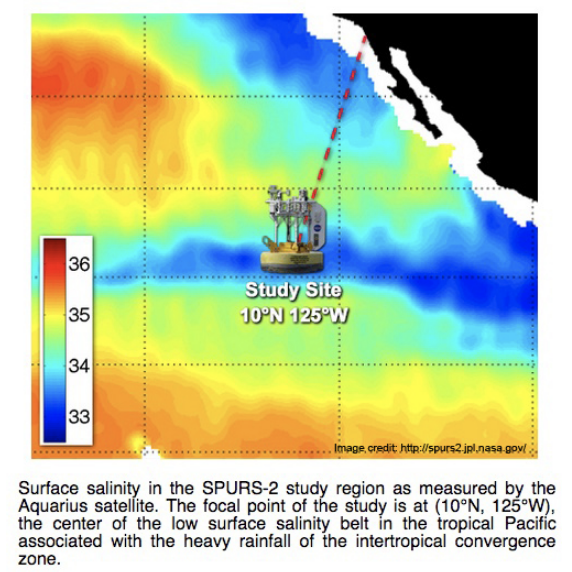SPURS-2
 The overall goal of the SPURS-2 field program is to understand the structure and variability of upper-ocean salinity under the inter-tropical convergence zone (ITCZ) in the region of the eastern tropical Pacific in 2016-2017. The Pacific ITCZ, with its frequent, heavy rainfall, is a major source of freshwater. Ultimately, this freshwater input contributes to the large-scale pattern of low SSS in the eastern tropical Pacific, but the initial input of freshwater is in “puddles” on the ocean surface with scales similar to the atmospheric mesoscale.
The overall goal of the SPURS-2 field program is to understand the structure and variability of upper-ocean salinity under the inter-tropical convergence zone (ITCZ) in the region of the eastern tropical Pacific in 2016-2017. The Pacific ITCZ, with its frequent, heavy rainfall, is a major source of freshwater. Ultimately, this freshwater input contributes to the large-scale pattern of low SSS in the eastern tropical Pacific, but the initial input of freshwater is in “puddles” on the ocean surface with scales similar to the atmospheric mesoscale.
There are several key scientific questions for the SPURS-2 field program:
- Where does the freshwater go? In other words, how does the ocean integrate the freshwater forcing and destroy the salinity variance created at the surface?
- By what oceanic processes is the freshwater transformed from shallow, patchy “puddles” of freshwater into the large-scale mean distribution of salinity that makes up the Eastern Pacific Fresh Pool?
- What impact will this horizontal and vertical variability have on the performance of satellite-based measurements of SSS?
- What are the local and non-local effects of the freshwater flux on the ocean?
- How does the ocean SSS impact the feedbacks on the atmosphere?
These are general issues that frame the interests of SPURS-2. More specifically, the program is expected to focus on certain physical processes, such as:
- Barrier layers and the role of salinity in upper-ocean stratification
- Surface fluxes
- Ocean/atmosphere Ekman layer coupling
- Salinity fronts and rainfall-induced “fresh pools”
- Influence of rain on remote sensing
Partners/Collaborators
This is a joint project with the University of Washington, University of North Carolina Wilmington, Scripps Institution of Oceanography, Earth & Space Research, NASA/JPL, and the NOAA Pacific Marine Environmental Laboratory

